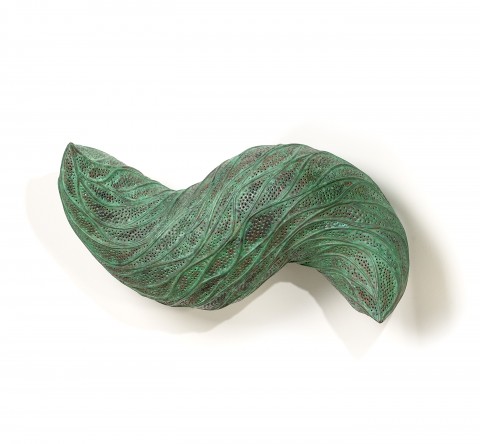LINK II, 1993
BRONWYN OLIVER
copper
30.0 x 69.0 x 21.0 cm
Roslyn Oxley9 Gallery, Sydney
Private collection, Sydney, acquired from the above in 1993
Bronwyn Oliver, Roslyn Oxley9 Gallery, Sydney, 21 July – 7 August 1993
Fenner, F., Bronwyn Oliver Mnemonic Chords, Moët et Chandon, Epernay, France, 1995, pp. 6, 24 (illus.)
Link, 1993, copper, 30.0 x 75.0 x 25.0 cm, in Fink, H., Bronwyn Oliver: Strange Things, Piper Press, Sydney, 2017, p. 219
The solid swollen form of Bronwyn Oliver’s copper Link II, 1993, corralled into a single sinusoidal wave segment, twists and strains with impressive physical tension. The warm verdigris patina and sinewy fluting of its surface allude to an unseen living form enclosed within this tapered carapace. As the title suggests, Link II might have been extracted from a larger whole – simplified to the smallest unit of life, an abstract building amoebic or cellular building block – ‘an almost involuntary, or purely animal force.’1 Fashioning an object that echoes primordial organic forms and animating its surface with repeating geometric patterns, Oliver adds Link II to the myriad enclosed seed forms of her oeuvre. Their rigid shells, either tightly woven and impregnable, rhythmically perforated or decoratively latticed in filigree copper wire, all contain a secret void – this invisible potential conveying an enduring possibility of metamorphosis.
Link II is covered with haptic webbed ridges, which run like veins along its planar surface, branching out and dovetailing to follow the rotational torsion of the sculpture’s overall curved structure. Although Link II is entirely enclosed, made with ribbons of plate copper rather than woven from coils of thin copper wire, its solidity is not impermeable. Like Breather and Halo – both from 1993, and also exhibited in Oliver’s exhibition at Roslyn Oxley9 Gallery in July that same year – the pale green surface of Link II’s shell is perforated. Contained within each bordered sliver, its irregular perforations are of varying diameters, although none are large enough to offer a glimpse inside Link II’s inky cavity. Hannah Fink, in her 2017 monograph on the artist, explains that Oliver had inherited through her education at Alexander Mackie College Lyndon Dadswell’s concept of space flowing through a sculpture.2 While the small apertures in Link II’s surface allow the sculpture to ‘breathe’, they provide precious little airflow through the sculpture’s form, in complete contrast to the delicate woven open-form works that Oliver had begun to create, and which would characterise much of the work throughout the remainder of her career.
The single twist of Link II’s tapered form references an early work by Oliver – Cloud, 1987, made from cane, paper and fibreglass resin, and exhibited in the 10th Mildura Sculpture Triennial. In the catalogue for this exhibition, Oliver described the formal concerns which had fed into the artwork’s construction: ‘The inner form I fabricated as a spiralling mass around a central axis. I cut the oval-shaped holes over the surface in an attempt to ‘dissolve’ the form. The holes were cut following the same spiralling curve as the form itself to try and emphasise a revolving movement.’ 3 Although Link II’s perforations do not attempt to suggest a physical dissolution, Oliver’s use of surface details to animate a static form, to endow it with an implied rotational potential, has clearly remained an enduring creative challenge. An applied chemical patina of verdigris creates for Link II an aura of weathered preciousness, its uneven application evoking the effects of the passage of time. A product of Oliver’s mature formal experimentations, Link II’s powerful presence expresses contradictory impulses of constriction and extension, concealment and revelation.
1. Fink, H., Bronwyn Oliver. Strange Things, Piper Press, Sydney, 2017, p. 107
2. Ibid, p. 51
3. The artist cited in 10th Mildura Sculpture Triennial 1988, Mildura Arts Centre, Mildura, 1988, cat. 95, np.
LUCIE REEVES-SMITH


